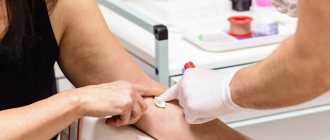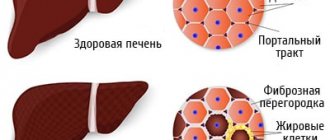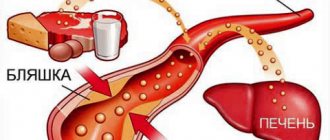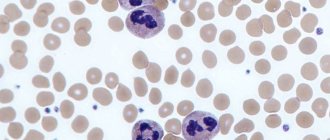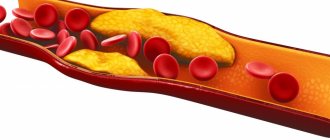Many people know that a cholesterol test is performed to diagnose lipid metabolism disorders and to assess the risk of developing a disease such as atherosclerosis. However, most do not have answers to these questions:
- Should this organic compound be present in the human body?
- In any quantity?
- Are the rates the same for men and women?
- Do cholesterol levels in women depend on hormone levels?
- What happens if the value is higher than normal or, conversely, lower?
And this is not the entire list of what a woman might think about when she hears about a cholesterol test. If questions arise, they should be asked to the appropriate specialist. But if this is not possible at the moment, then you can study at least basic information.
Cholesterol. What is it and why does everyone need it?
Cholesterol (or, in other words, cholesterol) is an organic compound that is produced by our body and also enters it with food. And not from any product. If we talk about food, it should be of animal origin: eggs, fish, meat, milk and offal. And in the human body, the liver acts as the main “factory” for the production of cholesterol. The substance is also formed in the intestinal walls, skin, adrenal glands and some other organs. There are certain values within which the cholesterol level in the blood is considered normal. Indicators for women and men differ not only by gender, but also by age. Nevertheless, cholesterol in a broad sense is a building material for cells. The organic compound is found in cell membranes; participates in the synthesis of vitamin D, sex hormones and metabolism. Thus, without cholesterol our body cannot function normally.
Foods that lower cholesterol
To normalize the condition, the doctor will recommend giving up foods high in animal fats, baked goods, smoked products, confectionery, strong tea and coffee.
Foods that lower cholesterol:
- lean meat and sea fish;
- cereals, legumes;
- fresh fruits and vegetables;
- vegetable oils (olive, corn);
- fresh juices.
Any nuts, as well as a mixture of garlic and lemon, will help cleanse blood vessels of cholesterol plaques.
Cholesterol – good or bad
The substance itself does not float in the blood. The compound is always surrounded by lipoproteins - complexes of proteins, fats and other components. Depending on the composition of these complexes, cholesterol can be converted into good or bad.
- When cholesterol levels in the blood rise, low-density lipoprotein (LDL) cholesterol often behaves poorly: it settles on the walls of blood vessels, forming plaques. If these “blockages” severely clog the blood vessels, cardiovascular diseases may develop.
- But with high-density lipoproteins (HDL, or HDL), the substance can be transferred from the plaques and organs themselves to the liver for further processing.
You cannot say that one type is needed and the other is not. Cholesterol with both high and low density lipoproteins is needed in the body. However, as with any system, balance is important. For advanced diagnostics, a blood test is usually taken:
- for total cholesterol;
- HDL;
- LDL;
- triglycerides.
Why is lipid metabolism disrupted in the body?
Lipid metabolism is a complex metabolic process. An important part is cholesterol metabolism. Its disorders are one of the main causes of cardiovascular diseases.
The disorder can occur for various reasons:
- heredity (in this case, the first symptoms appear in childhood);
- diseases of the gastrointestinal tract;
- endocrine pathologies;
- lack or excess of enzymes;
- kidney dysfunction;
- taking hormonal medications;
- bad habits;
- increased body mass index;
- physical inactivity.
For an adult, lipid metabolism disorders do not go unnoticed. Men experience hair loss prematurely, and women experience disruptions to their menstrual cycle. Excess cholesterol affects the condition of the skin and general well-being.
Upper and lower limits of normal for women. Table with main indicators
The data indicated in the table is for informational purposes only. To carry out tests, contact your local physician or a certified laboratory. IMPORTANT: only a doctor can correctly interpret the results, taking into account the patient’s medical history, her complaints (or lack thereof) and other diagnostic data.
| Age | Total cholesterol (TC), mmol/l | High-density lipoprotein cholesterol (good, HDL), mmol/l | Low-density lipoprotein cholesterol (bad, LDL), mmol/l | Triglycerides (TG), mmol/l |
| 15–20 years | 3,08–5,18 | 0,91–1,91 | 1,53–3,55 | 0,44–1,4 |
| 20–25 years | 3,16–5,59 | 0,85–2,04 | 1,48–4,12 | 0,41–1,48 |
| 25–30 years | 3,32–5,75 | 0,96–2,15 | 1,84–4,25 | 0,42–1,63 |
| 30–35 years | 3,37–5,96 | 0,93–1,99 | 1,81–4,04 | 0,44–1,70 |
| 35–40 years | 3,63–6,27 | 0,88–2,12 | 1,94–4,45 | 0,45–1,99 |
| 40–45 years | 3,81–6,53 | 0,88–2,28 | 1,92–4,51 | 0,51–2,16 |
| 45–50 years | 3,94–6,86 | 0,88–2,25 | 2,05–4,82 | 0,52–2,42 |
| 50–55 years | 4,20–7,38 | 0,96–2,38 | 2,28–5,21 | 0,59–2,63 |
| 55–60 years | 4,45–7,77 | 0,96–2,35 | 2,31–5,44 | 0,62–2,96 |
| 60–65 years | 4,45–7,69 | 0,98–2,38 | 2,59–5,80 | 0,63–2,70 |
| 65–70 years | 4,43–7,85 | 0,91–2,48 | 2,38–5,72 | 0,68–2,71 |
| > 70 years | 4,48–7,25 | 0,85–2,38 | 2,49–5,34 | 0,68–2,71 |
Why does the cholesterol level for women change as they age?
Usually, when talking about high cholesterol, it is LDL levels that are meant. If you look at the entire table above, you can easily notice that with age, the level of the substance in the blood increases. Therefore, we can conclude that LDL (and not only them) are increasingly appearing in the blood. Of course, this is not a constant proportional increase upward. The increase occurs up to a certain age of the woman. After approximately 65 years, the concentration of cholesterol in the blood begins to fall along with the normal limits. Why does concentration increase with age? The question is good and simple, so the answer is short: the older a person gets, the more connective tissues grow in the body and fat deposits form, all this provokes an increase in cholesterol levels. It is for this reason that it is worth monitoring cholesterol, HDL, LDL and triglycerides throughout your life.
High cholesterol: symptoms
High cholesterol can be recognized by the patient's symptoms such as:
- severe pain in the legs even with little physical activity;
- squeezing pain in the heart;
- cholesterol deposits under the skin.
If such symptoms are identified, an urgent consultation with a specialist is necessary, who will tell you how to treat high cholesterol and which drugs will have the maximum effect in this case.
On our website you can make an appointment with a therapist, who will give you a referral for tests and then interpret their results. After the examination, the doctor will prescribe a course of treatment and monitor its implementation.
How can you maintain normal cholesterol?
- To refuse from bad habits.
Alcohol and smoking negatively affect health, including good cholesterol levels. Give up these two bad habits - and your body will probably thank you with improved well-being and mood. - Eat properly.
Yes, it’s hard, because you really want fatty, fried, sweet... But hard doesn’t mean impossible! Start the process gradually. For example, first remove sweets, then a week later – fried foods, and after another week – fatty foods. Keep a diary recording your weight, cholesterol levels and other achievements. This way you will see the dynamics, which is usually the motivation for further action. If necessary, consult a nutritionist. A specialist will help you create a healthy diet. The Herbalife Nutrition company has developed a line of products that, in combination with proper nutrition, moderate sports activities and in the absence of contraindications, can help the body saturate cells with useful substances and get rid of toxins and waste.- "Thermo Complete". Can normalize metabolic processes, saturate and tone tissues.
- "Roseguard." Helps prolong youth at the cellular level and cleanse cells of antioxidants.
- Nightworks. Can be used to normalize the functioning of the cardiovascular system and saturate the blood with nitrogen.
- "Cell Activator". Helps quickly transform fat cells into energy.
- Exercise.
It is not necessary to do kilometer runs in the park, although some will like it. Take a walk, walk, join a pool or gym. If the park is far away, run at the stadium in the next yard. Is it hard to run? Another option is Nordic walking. Think about what would be interesting and enjoyable for you. Need some company? Invite your husband, girlfriend, child or other loved one with you. Treat sports not as a compulsion, but as part of your lifestyle.
Women need cholesterol. Undoubtedly. However, keep an eye on its level. Carry out control at least once a year and regardless of age. But remember that it usually depends on age what the upper and lower limits of normal cholesterol for a woman will be.
Five unexpected reasons why cholesterol jumped
So why might cholesterol rise? The reasons may be the most unexpected.
Photo: GLOBAL LOOK PRESS
The “total cholesterol” indicator means nothing
“Cholesterol is a kind of “scarecrow” of modern medicine,” says our regular expert, nutritionist Lyudmila Denisenko. - This is on the one hand. On the other hand, it is a way to enrich pharmaceutical monsters, because drugs to lower blood cholesterol - statins - always cost a lot.
In fact, even babies need cholesterol, and they get it from their mother's milk. Cholesterol is the “building blocks” of our brain, hormones, nerve endings, cell membranes...
And when we are called to “lower cholesterol levels,” we need to understand why and what kind of cholesterol we need to “lower.”
It is important to understand that we get only about 20% of the cholesterol we need from food, the remaining 80 is synthesized in our body. On average, each adult normally contains about 2 grams of cholesterol per kilogram of body weight. That is, with a weight of 70 kg - about 140 g of cholesterol.
Remember that there is no “good” or “bad” cholesterol in your plate; it becomes such in our liver, kidneys, adrenal glands, gonads, intestines and skin - the places where cholesterol formation occurs.
When patients start telling me that their therapist or cardiologist recommended a diet because their cholesterol is “higher than normal,” I immediately warn that the “total cholesterol” indicator means nothing! You need to know which cholesterol – “good” or “bad” – is responsible for this increase.
Say no to statins
“Good” cholesterol - HDL (high-density lipoprotein) can be arbitrarily high, although laboratories also give the upper limit of its “norm”. But if “bad” cholesterol is increased - LDL and LDL (low and very low density lipoproteins) - then you need to take care of reducing it. Just one request - no statins! Even if your doctors insistently offer them to you.
(Cardiologists, of course, may have their own opinion about prescribing medications. But even they clarify: statins are prescribed not for high cholesterol, but for a high risk of vascular diseases, and the risk is assessed taking into account cholesterol - Ed .)
Statins, like doctors who have not delved very deeply into the topic, sometimes do not understand which cholesterol is “good” and which is “bad”, and reduce everything. Google it and see how many scientific studies have now appeared about the dangers of statins, that they can lead to senile dementia and even Alzheimer’s disease.
So why might cholesterol rise? The reasons may be the most unexpected.
1. It’s not about food, but about heredity or place of residence
Why is it so unfair - someone can eat sandwiches with butter and caviar, topped with scrambled eggs, and still remain healthy until old age, while someone literally on water and bread has that very “high” cholesterol level that is blamed for all mortals? sins - atherosclerosis, strokes, heart attacks and other diseases of civilization?
And most importantly - what to do? Should you urgently go on a diet, eliminating all foods containing cholesterol from your diet? Take your time, because our body, sensing a deficiency of cholesterol in the incoming food, will simply begin to synthesize it more! The facts speak about this, because even vegans - people who have completely abandoned animal foods (and as you remember, cholesterol is found only in animal products) - hypercholesterolemia - an increase in cholesterol levels in the blood - is quite common. All the reasons for this have not yet been clarified; heredity, stress, bad habits, and even place of residence play a role here. It is known, for example, that residents of the Far North, whose diet is dominated by animal products, have virtually no atherosclerosis.
The cause of increased cholesterol is quite often diseases of the liver and intestines, because this is where endogenous cholesterol is synthesized.
2. Hormone deficiency is to blame
Most doctors recognize that one of the main reasons for increased cholesterol is... deficiencies. First of all, there is a deficiency of sex hormones. I already said above that cholesterol is extremely important for the synthesis of sexual hormones, but with age their production decreases, which means that “extra” cholesterol appears. What to do? Compensate for deficiency of sex hormones. Hormone replacement therapy from a certain age will also help reduce cholesterol, because the body, realizing that the level of these hormones is normal, will stop synthesizing “extra” cholesterol.
Another deficiency is thyroid hormones, which, alas, is becoming more common. It can also be adjusted perfectly and our doctors are excellent at doing it.
3. Not enough vitamin D
What other deficiencies cause high cholesterol? Vitamin D deficiency (and it is observed in at least 80% of the inhabitants of Russia, and even in sunny southern Sochi. The reason is banal - sunscreens, rare exposure to the open sun in the most favorable morning and pre-sunset hours, a shortage of products containing this vitamin (in first of all - fresh sea fish and seafood). How to compensate? It is clear that in Sochi you can sunbathe in the sun and eat black sea mullet, but it is not a fact that your intestinal microflora is in order and synthesizes inactive vitamin D from inactive vitamin D (from the sun and food) its active form. What should Muscovites or Murmansk residents do? Take vitamin D in the form of medications. Everyone, from infants to very old people. Maintenance dose - 100 thousand IU per month, therapeutic dose (for a deficiency of the vitamin detected in the blood) will be prescribed only a doctor.
4. Ate little fish
Another deficiency is omega-3 fatty acids. Again, where in our diet is fresh sea fish from the northern seas, rich in this essential nutrient? Not the suspiciously red-orange salmon from our supermarkets, raised on farms on artificial feeds and additives, and having virtually no omega-3 fatty acids, but small fresh fish - mackerel, anchovies, herring - “grazed” in the open sea and not frozen on our tables? If you are unlucky enough to be born and live in the northern seas, there is a way out - omega-3 supplements, and only those in which the content of EPA + DHA (don’t worry about their full name, remember these abbreviations) is above 50% per capsule and obtained exactly from this small fish. How to check if you have enough omega? Donate blood for omega-3 index. And it should ideally be 12-13, and for most of us it is about 3... High cholesterol is also affected by a deficiency of iron, iodine, vitamin B12...
5. And went too far with sugar
But the same high cholesterol is also affected by... excess! But not fat in foods, which we are constantly afraid of (remember the Eskimos and their seal fat in their diet), but sugar! It is sugar, starting from refined white sugar, which you like to add to tea, and ending with “hidden” sugar, which is found in almost all industrially processed products - bread, cheese, sausage, canned food, baked goods, sweets, juices, drinks...
The food basket of today's Russian contains only refined sugar - 24 kg per year. “Hidden” sugar is almost impossible to count. And it is sugar that causes plaques in blood vessels. Attaching to hemoglobin, sugar molecules turn it into “hedgehogs” - glycated Hb - which “scratch” the walls of blood vessels, and in order to patch up these wounds, our body begins to synthesize more cholesterol, which is a kind of putty for these mucosal defects. This is how atherosclerotic plaques appear.
ON A NOTE!
Eggs and lard - yes
But it’s time to justify eggs, butter, lard, which are accused of all mortal sins! The same eggs contain choline, which removes “bad” cholesterol, and lard contains arachidonic acid, which is extremely necessary for us, which has the same effect. I am silent about butter, which contains vitamins A, D, E, C, B, calcium, phospholipids (building material for cells, especially nerve cells) and essential amino acids.
But don’t rush to run to the market tomorrow for fatty cottage cheese and sour cream; excess fat in your diet will increase not cholesterol, but the amount of fat – subcutaneous and internal. But excess weight is almost 100% high cholesterol.
Is it worth using vodka to “clean vessels”?
Do not listen to “folk” advice that a glass of vodka “cleanses” blood vessels. She doesn't clean anything. In addition, alcohol abuse leads to fatty liver degeneration, one of the causes of increased cholesterol in the blood. But resveratrol in red wine helps remove “bad” cholesterol and is a strong antioxidant that protects our organs and tissues from free radicals - the cause of inflammation and even cancer. But remember the dose - 150 - 200 ml per day, no more.
IMPORTANT!
What diet will really lower cholesterol?
Already from the above, it is clear that these are fish and seafood containing vitamin D and omega-3, as well as complete protein - rich in choline, essential amino acids and, in particular, methionine. Choline and methionine are used by the body to synthesize phospholipids, in particular lecithin, which forms hydrophilic lipoprotein complexes with cholesterol. Lipotropic substances also prevent fatty infiltration of the liver, thereby ensuring its normal functioning. Lean meats, lean fish, cottage cheese, skim milk, egg whites, legumes (soybeans, peas), spinach, oatmeal, and herring are rich in choline. There is a lot of methionine in lamb, pike perch, cod, legumes (soybeans, peas, beans), and buckwheat. For more details, see below.
SPECIFICALLY
The following products and dishes made from them are recommended:
— Vegetables, fruits, berries (fresh, frozen and dry), mushrooms.
— Milk and some dairy products in their natural form (low-fat, but not low-fat cottage cheese, curdled milk, kefir, fermented baked milk).
— Buckwheat, oatmeal, wheat cereals, legumes, pasta made from durum wheat.
— Meat (veal, beef), skinless poultry (turkey, chicken).
- Low-fat varieties of fish (cod, perch, pike, pike perch), and 2-3 times a week - fatty varieties of fish containing omega-3 (wild salmon, herring, mackerel, mackerel, sardines, etc.)
— Unrefined vegetable oil (linseed, olive) and butter.
- 2-3 times a week - eggs and dishes made from them.
— Seafood (shrimp, mussels, squid, scallop, seaweed).
— Coarsely ground rye and wheat bread.
And don't forget about physical activity! Not exhausting training, but feasible, but regular, let it be what you like - walking, walking at a fast pace, dancing, swimming, rollerblading or cycling, skating or skiing - but be sure to do it regularly! And better - in the fresh air.
